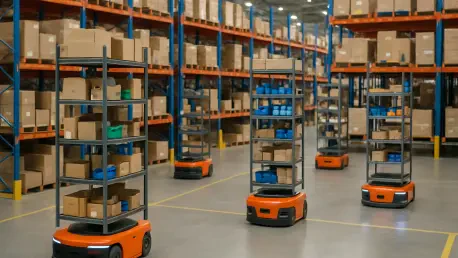The warehouse industry is undergoing a profound transformation, driven by the explosive growth of e-commerce and an unrelenting demand for faster, more accurate order fulfillment that challenges traditional logistics models. As supply chains grapple with mounting pressures—from skyrocketing consumer expectations to persistent labor shortages—businesses are increasingly turning to cutting-edge robotics to revolutionize one of the most labor-intensive tasks in warehousing: order picking. This process, often the bottleneck in fulfillment operations, is being redefined by automation technologies that promise not only speed but also precision and scalability. From autonomous mobile robots (AMRs) navigating sprawling facilities to AI-driven systems optimizing every movement, these innovations are turning warehouses into hubs of efficiency and adaptability. The impact is far-reaching, addressing critical issues like worker safety, operational costs, and the ability to meet same-day delivery demands. This exploration delves into the myriad ways robotic solutions from industry leaders like Amazon, DHL Group, and Siemens, alongside trailblazers such as Brightpick and Ambi Robotics, are reshaping the logistics landscape. By examining the push for productivity, safety enhancements, flexibility, and the role of artificial intelligence, a clear picture emerges of an industry at a technological tipping point, poised to redefine how goods move from shelf to doorstep in an increasingly digital world.
Driving Unmatched Efficiency in Operations
The core mission of warehouse robotics lies in elevating efficiency to levels unattainable by manual processes alone. Systems like Ambi Robotics’ AmbiStack leverage artificial intelligence to stack random boxes at rates that outstrip human capabilities, ensuring pallets are built with speed and precision. Meanwhile, Brightpick’s Autopicker 2.0 achieves an impressive 70-80 picks per hour, rivaling human productivity while maintaining robotic consistency across long shifts. This focus on throughput is not just about numbers; it represents a fundamental shift in how warehouses handle the sheer volume of orders driven by online shopping trends. DHL Group’s Stretch robots further exemplify this trend, unloading up to 700 cases per hour and slashing the time needed for critical tasks like container processing. Such advancements highlight a consistent theme: robotics can outperform traditional labor in both speed and accuracy, setting new standards for what’s possible in order picking. Beyond raw output, these technologies minimize errors that often plague manual operations, ensuring that the right items reach customers without costly delays or returns. This efficiency is particularly vital as businesses strive to meet tighter delivery windows, often transitioning from two-day to same-day shipping promises. The ripple effect is felt across the supply chain, where faster picking translates to quicker turnarounds and heightened customer satisfaction, positioning companies to stay competitive in a crowded market.
Moreover, the drive for productivity through robotics isn’t limited to high-speed picking or unloading. It extends to optimizing every facet of warehouse workflows, ensuring that bottlenecks are systematically eliminated. Take, for instance, the integration of robotic systems with existing conveyor belts and sorting mechanisms, which streamlines the transition from picking to packing. Amazon’s vast network, now boasting one million robots, demonstrates this by using AI-driven coordination to reduce travel time by 10%, meaning robots spend less time navigating and more time executing tasks. This level of optimization is crucial in large-scale facilities where even small delays can compound into significant losses. Additionally, the ability of robots like those from DHL to operate continuously without fatigue further amplifies throughput, allowing warehouses to handle peak seasons without the need for temporary staffing surges. The result is a leaner operation where resources are allocated more effectively, reducing overhead while maximizing output. As these systems become more widespread, they are not only redefining benchmarks for efficiency but also pushing businesses to rethink their entire operational models, prioritizing automation as a cornerstone of growth and resilience in an unpredictable market.
Prioritizing Worker Safety and Ergonomic Relief
A significant benefit of warehouse robotics lies in its capacity to alleviate the physical burden on workers, addressing long-standing concerns about safety and ergonomics in labor-intensive environments. DHL Group’s Stretch robots are a prime example, taking on grueling tasks such as unloading heavy containers in extreme conditions like freezing or sweltering temperatures, which often pose health risks to human employees. By automating these high-stress activities, companies can reduce workplace injuries and improve overall job satisfaction, allowing staff to focus on roles that require human judgment and creativity. Similarly, Applied Manufacturing Technologies (AMT) offers collaborative palletizing solutions using FANUC robots, which handle repetitive case stacking—a task notorious for causing strain injuries over time. This shift not only protects workers from physical harm but also fosters a workplace culture where employee well-being is visibly prioritized. The broader implication is clear: robotics isn’t just a tool for efficiency but a means to create safer, more sustainable working conditions, which in turn can enhance retention in an industry often plagued by high turnover rates due to physical demands.
Equally important is the long-term impact of these ergonomic advancements on workforce dynamics and operational stability. When robots assume tasks that involve heavy lifting or prolonged repetitive motions, the risk of chronic injuries such as back pain or joint issues diminishes significantly, leading to fewer workers’ compensation claims and less downtime due to medical leave. Beyond individual health, this creates a ripple effect on morale, as employees see tangible investments in their safety through technologies like AMT’s palletizers or DHL’s automated unloading systems. Furthermore, safer environments enabled by robotics can attract a more diverse workforce, including those who might otherwise be deterred by the physical demands of traditional warehouse roles. This opens opportunities for older workers or those with physical limitations to contribute meaningfully, broadening the talent pool at a time when labor shortages remain a critical challenge. As robotics continues to evolve, the emphasis on ergonomic design in systems—ensuring they complement human capabilities rather than compete with them—will likely become a standard expectation, reinforcing the idea that automation and human welfare can advance hand in hand within the logistics sector.
Adapting with Flexibility and Scalable Solutions
Flexibility stands as a hallmark of modern warehouse robotics, enabling systems to adapt swiftly to the ever-changing demands of logistics operations. Ambi Robotics’ AmbiStack exemplifies this with its modular design, capable of sorting and stacking to multiple pallets using a single machine, which eliminates the need for extensive retooling when product lines change. Similarly, AMT’s collaborative palletizing solutions allow for rapid reconfiguration to handle different products without requiring specialized engineering support, making them ideal for warehouses dealing with diverse inventories. This adaptability is crucial in an era where consumer preferences shift rapidly, often necessitating quick adjustments in order fulfillment strategies. Yale’s Relay automated lift truck platform pushes this concept further by offering a no-code, drag-and-drop interface that lets operators adjust routes and tasks in real-time, ensuring seamless scalability during demand spikes. Such features empower businesses to respond to market fluctuations without incurring significant downtime or costs, positioning robotics as a dynamic tool for operational agility in a competitive landscape.
Scalability, closely tied to flexibility, ensures that robotic solutions can grow alongside a company’s needs, from small warehouses to sprawling distribution centers. The ability to integrate additional units or reassign robots to new tasks without overhauling infrastructure is a game-changer, as seen with systems like Yale’s Relay platform, which supports rapid implementation through rental models that bundle costs into manageable monthly fees. This approach allows businesses to test automation on a smaller scale before committing to full deployment, mitigating financial risk while still reaping the benefits of enhanced picking efficiency. Moreover, scalable designs mean that warehouses can handle seasonal peaks or unexpected order surges by simply adjusting robotic workflows, rather than hiring temporary labor—a process often fraught with training delays and inconsistency. The emphasis on modular and user-friendly systems also reduces the learning curve for staff, ensuring that scaling up doesn’t come at the expense of operational hiccups. As robotics becomes more accessible through such innovative frameworks, even smaller players in the logistics field can adopt automation, leveling the playing field and driving industry-wide transformation in how order picking adapts to future challenges.
Harnessing AI and Data for Smarter Operations
Artificial Intelligence (AI) serves as the backbone of the robotic revolution in warehouses, enabling systems to operate with a level of precision and adaptability that was once unimaginable. Amazon’s DeepFleet AI model optimizes robot coordination across its network of one million units, cutting travel time by 10% and ensuring that bots spend more time on productive tasks rather than unnecessary navigation. Siemens’ Simatic Robot Pick AI Pro takes this further by enabling 3D picking of unknown objects without pre-modeled data, allowing robots to handle a vast array of items in e-commerce settings with speed and accuracy. These AI-driven systems continuously learn from real-world interactions, refining their performance over time to address complex challenges like dynamic inventory changes or unpredictable order patterns. The result is a smarter warehouse where every movement is calculated for maximum efficiency, reducing waste and enhancing throughput in ways that manual processes could never achieve. This technological leap is particularly critical as order picking becomes more intricate with the rise of personalized shopping and smaller, more frequent orders.
Data-driven optimization, a key component of AI integration, further amplifies the impact of robotics by providing actionable insights that refine operations in real-time. Brightpick’s Intuition software, powered by Physical AI, mimics human-like precision in picking tasks, using advanced sensors and algorithms to adjust to varying item shapes and weights without hesitation. This capability ensures that even the most delicate or irregularly shaped products are handled correctly, minimizing damage and returns—a persistent pain point in logistics. Beyond individual task execution, data analytics embedded in these systems can predict potential slowdowns or maintenance needs, allowing managers to address issues before they disrupt workflows. The convergence of AI with Internet of Things (IoT) technologies, as seen in DHL’s network of 800,000 sensors, creates a connected ecosystem where robots communicate seamlessly with other equipment and human operators, optimizing space usage and energy consumption. As these intelligent systems become more sophisticated, they pave the way for fully autonomous warehouses where human intervention is minimal, yet oversight remains robust, ensuring that order picking evolves into a process defined by precision, foresight, and relentless improvement.
Balancing Safety and Cost-Effectiveness
Safety remains a paramount concern as robots and humans increasingly share warehouse spaces, prompting companies to embed robust protective measures into their systems. Arvato’s rack-to-person setup in Poland illustrates this commitment, utilizing sensor gates to prevent accidental employee entry into active robot zones, thereby reducing the risk of collisions or injuries in busy logistics centers. Ambi Robotics also prioritizes security, implementing strict data encryption and regular audits to safeguard sensitive customer information processed by their systems. These measures address not only physical safety but also cybersecurity—a growing concern as warehouses become more digitized and interconnected. The emphasis on creating secure environments extends to the design of collaborative robots, which are engineered to operate alongside workers with built-in safeguards like force sensors that halt movement upon detecting unexpected contact. This focus ensures that automation enhances rather than endangers the workplace, fostering trust in robotic solutions as integral components of modern order picking processes.
Cost-effectiveness, equally critical to the adoption of robotics, is being tackled through innovative pricing models that lower financial barriers for businesses of varying scales. Brightpick’s Robots-as-a-Service (RaaS) model, starting at $1,900 per robot per month, offers an affordable entry point for companies hesitant to make large upfront investments, while Yale’s Relay platform bundles all expenses into a monthly rental fee, simplifying budgeting and scalability. AMT’s collaborative palletizing solution, priced under $120,000, promises a return on investment within a year, making it an attractive option for industries like food and pharmaceuticals where margins are often tight. These approaches democratize access to automation, allowing smaller warehouses to compete with larger players by leveraging the same cutting-edge tools without overextending resources. Furthermore, the cost savings from reduced labor dependency and minimized errors during picking contribute to long-term financial benefits, reinforcing the economic viability of robotics. Together, the dual focus on safety and affordability is reshaping how warehouses approach automation, ensuring that the transition to robotic order picking is both secure and sustainable for the future of logistics.
Reflecting on a Transformative Journey
Looking back, the journey of warehouse robotics in redefining order picking reveals a landscape where technology meets pressing operational needs with remarkable ingenuity. Solutions like autonomous mobile robots, AI-driven systems, and collaborative palletizers from pioneers such as DHL Group, Amazon, and Brightpick demonstrate an unwavering commitment to efficiency, achieving feats like 700 cases unloaded per hour or 70-80 picks matching human rates. Safety and ergonomics stand as equal priorities, with innovations like sensor gates and automated heavy lifting easing the burden on workers while fostering secure environments. Flexibility shines through modular designs and no-code platforms, ensuring adaptability to shifting demands, while AI and data analytics empower robots to learn and optimize relentlessly. Cost models like RaaS and rentals make automation accessible, proving that scale needn’t be a barrier to progress. Moving forward, businesses must focus on strategic implementation—aligning systems with evolving delivery expectations, prioritizing preventive maintenance, and leveraging data to preempt disruptions. The path ahead calls for continuous refinement, ensuring robotics evolve alongside market needs to sustain their transformative impact. As the industry builds on these foundations, exploring hybrid human-robot workflows and deeper AI integration will be key to unlocking the next chapter of warehouse efficiency.









